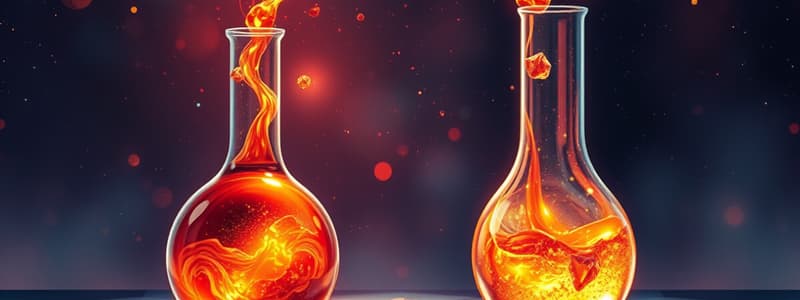Podcast
Questions and Answers
What property of solids allows them to maintain a fixed shape?
What property of solids allows them to maintain a fixed shape?
- Particles can slide past one another.
- Particles are closely packed in a fixed arrangement. (correct)
- Particles are far apart.
- Particles move freely.
How do liquids differ from solids in terms of volume?
How do liquids differ from solids in terms of volume?
- Liquids have fluctuating volume.
- Liquids maintain a definite volume. (correct)
- Liquids have no definite volume.
- Liquids change volume based on temperature.
What is true about the particle movement in gases?
What is true about the particle movement in gases?
- Particles are arranged in a fixed pattern.
- Particles are closely packed.
- Particles move freely and rapidly in all directions. (correct)
- Particles vibrate in place.
Which of the following statements about the density of gases is correct?
Which of the following statements about the density of gases is correct?
What occurs when a solid transitions to a liquid?
What occurs when a solid transitions to a liquid?
Which statement is accurate regarding the compressibility of liquids?
Which statement is accurate regarding the compressibility of liquids?
What determines the boiling point of a liquid?
What determines the boiling point of a liquid?
In which state do particles have a fixed arrangement and vibrate in place?
In which state do particles have a fixed arrangement and vibrate in place?
Which of the following best describes the process of vaporization?
Which of the following best describes the process of vaporization?
What effect does increasing temperature generally have on gas pressure if volume is constant?
What effect does increasing temperature generally have on gas pressure if volume is constant?
Flashcards are hidden until you start studying
Study Notes
Matter State
Solid Properties
- Shape and Volume: Solids have a definite shape and volume.
- Particle Arrangement: Particles are closely packed together in a fixed arrangement.
- Particle Movement: Particles vibrate in place but do not move freely.
- Density: Generally have high density due to closely packed particles.
- Compressibility: Solids are incompressible; little to no change in volume under pressure.
- Melting Point: Solids have a specific melting point, where they transition to liquid.
Liquid Properties
- Shape and Volume: Liquids have a definite volume but take the shape of their container.
- Particle Arrangement: Particles are close together but not in a fixed position, allowing for flow.
- Particle Movement: Particles can slide past one another, resulting in fluidity.
- Density: Generally have lower density than solids but higher than gases.
- Compressibility: Liquids are slightly compressible.
- Boiling Point: Liquids have a specific boiling point, where they transition to gas.
Gas Properties
- Shape and Volume: Gases have no definite shape or volume; they expand to fill their container.
- Particle Arrangement: Particles are far apart and not arranged in any specific pattern.
- Particle Movement: Particles move freely and rapidly in all directions.
- Density: Gases have low density compared to solids and liquids.
- Compressibility: Gases are highly compressible; volume can change significantly under pressure.
- Temperature Effects: Increasing temperature generally increases gas pressure if volume is constant (Charles's Law).
Changes of State
- Melting: Transition from solid to liquid; occurs at a solid's melting point.
- Freezing: Transition from liquid to solid; occurs at a liquid's freezing point.
- Vaporization: Transition from liquid to gas; includes boiling (rapid vaporization) and evaporation (slow vaporization).
- Condensation: Transition from gas to liquid; occurs when gas cools and loses energy.
- Sublimation: Direct transition from solid to gas without becoming liquid (e.g., dry ice).
- Deposition: Direct transition from gas to solid without becoming liquid (e.g., frost formation).
Solid Properties
- Solids maintain a definite shape and volume.
- Particles in solids are closely packed in a fixed arrangement, limiting movement.
- In solids, particles vibrate in place without moving freely.
- Solids typically have high density due to closely packed particles.
- Solids are generally incompressible, with minimal change in volume under pressure.
- Each solid has a specific melting point at which it transitions to a liquid state.
Liquid Properties
- Liquids possess a definite volume but adopt the shape of their container.
- Particles in liquids are close together but allow for some flow, leading to fluid dynamics.
- Particle movement in liquids enables them to slide past one another, contributing to fluidity.
- Liquids have lower density compared to solids but higher density than gases.
- Liquids exhibit slight compressibility, allowing for some volume change under pressure.
- A specific boiling point defines when a liquid transitions to a gaseous state.
Gas Properties
- Gases lack a definite shape or volume, expanding to fill any container fully.
- Particles in gases are spaced far apart and not organized in a specific pattern.
- Gas particles move freely and rapidly in all directions, resulting in low density.
- Gases are highly compressible; significant volume changes can occur under pressure.
- Charles's Law states increasing temperature raises gas pressure when volume is constant.
Changes of State
- Melting is the process of a solid transitioning to a liquid at its melting point.
- Freezing refers to a liquid becoming a solid at its designated freezing point.
- Vaporization encompasses the transition from liquid to gas, including boiling and evaporation.
- Condensation is the process where gas cools and loses energy, becoming a liquid.
- Sublimation occurs when a solid transitions directly to a gas without becoming liquid, as seen with dry ice.
- Deposition refers to gas transforming directly into a solid, exemplified by the formation of frost.
Studying That Suits You
Use AI to generate personalized quizzes and flashcards to suit your learning preferences.




